Learn all you need in this Rice Cooker Buying Guide
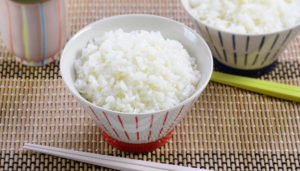
Are you looking to buy a rice cooker for your kitchen, but you’re not sure where to start? A good rice cooker can make a lovely batch of soft, fluffy, fresh rice with the press of a button. There are dozens of models available, from very simple, inexpensive cookers to deluxe, do-it-all cookers costing a small fortune. So, which is the right one for you? HowToBuyA will give you the information you need to buy the right rice cooker for you. We’ll also share some links to rice cookers that may suit your needs. Want to skip the How To and get straight to the links? Click here for some HowToBuyA – Rice Cooker Suggestions.
Affiliate notice: When you buy through our links, we may earn a commission.
Sections of this Rice Cooker Buying Guide
- Rice Cooker Basics
- How to Use a Rice Cooker
- How Rice Cookers Work
- What to Look for When Buying a Rice Cooker
- Rice Cooker Suggestions
- Non-Zojirushi Rice Cookers
- Rice Cookers below $50
- Rice Cookers from $50 to $100
- Rice Cookers from $100 to $200
- Zojirushi Rice Cookers
- Zojirushi Rice Cookers – Made in Japan
- Zojirushi Rice Cookers – Made in China
- Wrap Up
Rice Cooker Basics
If you have never used a rice cooker, don’t worry! They are fairly straightforward and easy to use. To help you choose the best rice cooker for your needs, let’s first go over some basic knowledge about rice cookers: how to use a rice cooker and how a rice cooker works.
How to Use a Rice Cooker
Wash the uncooked rice
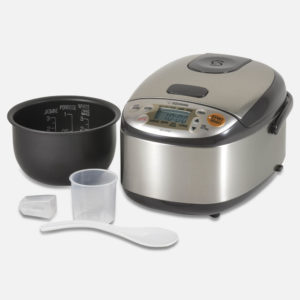 Your rice cooker should come with a removable inner pot, a rice cup, and a plastic or wooden scoop. Fill the rice cup to the top and level off. This is one cup of uncooked rice, which will yield 2 cups of cooked rice. Pour your desired amount of rice into the inner pot. Fill the pot with water until the rice is submerged. Avoid using hot water. Stir with your hand to wash the rice, removing starch and unwanted particles. Drain the starchy water and repeat until the water remains mostly clear.
Your rice cooker should come with a removable inner pot, a rice cup, and a plastic or wooden scoop. Fill the rice cup to the top and level off. This is one cup of uncooked rice, which will yield 2 cups of cooked rice. Pour your desired amount of rice into the inner pot. Fill the pot with water until the rice is submerged. Avoid using hot water. Stir with your hand to wash the rice, removing starch and unwanted particles. Drain the starchy water and repeat until the water remains mostly clear.
Add water
Rice needs an appropriate amount of water to cook. Too much water, your rice may come out mushy. Too little water, your rice will definitely be hard and dry. There are markings inside the pot to show how much water to add per cup of rice. 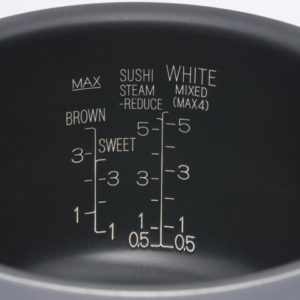 Fill the pot with water to the appropriate line for your amount of rice. Remember to use the rice cup provided with the machine when using these markings. A typical rice cup is not equal to the American standard of a cup. A rice cup uses the Japanese standard, which is 180ml or approximately 3/4 of an American cup. So, if you use an American measuring cup to put in a cup of rice, the line-markings inside the pot will not be accurate. Your rice will come out dry. If you do not have a rice cup, a 1-to-1 ratio of water to rice usually works well. Japanese people often use a 1-to-1.1 ratio, so 200ml of water per rice cup. You may have to test your particular machine out a few times and adjust the water amount to find the best ratio for your tastes. You can also try letting the rice soak in the water for up to 30 minutes before cooking to improve results. This step is probably unnecessary with more advanced models, which have soaking time built into the program.
Fill the pot with water to the appropriate line for your amount of rice. Remember to use the rice cup provided with the machine when using these markings. A typical rice cup is not equal to the American standard of a cup. A rice cup uses the Japanese standard, which is 180ml or approximately 3/4 of an American cup. So, if you use an American measuring cup to put in a cup of rice, the line-markings inside the pot will not be accurate. Your rice will come out dry. If you do not have a rice cup, a 1-to-1 ratio of water to rice usually works well. Japanese people often use a 1-to-1.1 ratio, so 200ml of water per rice cup. You may have to test your particular machine out a few times and adjust the water amount to find the best ratio for your tastes. You can also try letting the rice soak in the water for up to 30 minutes before cooking to improve results. This step is probably unnecessary with more advanced models, which have soaking time built into the program.
Start the rice cooker
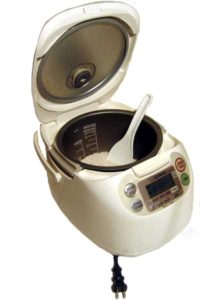 Close the lid. Most rice cookers are set to cook white rice without any adjustment. If you are cooking another variety, change the settings appropriately according to the instruction manual. Press the start button. Cooking time varies greatly depending on the type and amount of rice and the model of rice cooker. Most rice cookers will chime when finished. Use a rice scoop to stir up the rice. This will release excess moisture for fluffier rice. That’s it. You now have fresh rice ready to eat.
Close the lid. Most rice cookers are set to cook white rice without any adjustment. If you are cooking another variety, change the settings appropriately according to the instruction manual. Press the start button. Cooking time varies greatly depending on the type and amount of rice and the model of rice cooker. Most rice cookers will chime when finished. Use a rice scoop to stir up the rice. This will release excess moisture for fluffier rice. That’s it. You now have fresh rice ready to eat.
Keep it warm
Once the rice is finished, the cooker should automatically switch to a keep-warm mode. Depending on your rice cooker, you should be able to keep your cooked rice in the rice cooker using this mode for 12 to 24 hours. Some machines have an extended keep-warm function, although the freshness of the rice will decrease over time. Follow the manual for guidance on how long you can keep cooked rice in the cooker.
Care & Maintenance
The removable inner-pots of most rice cookers have a coating to prevent the rice from sticking to the pot. To prevent this nonstick coating from peeling or chipping off, never use any kind of metal utensil inside the pot. To be extra cautious, you can wash the uncooked rice in a separate bowl. When removing cooked rice, use only the plastic or wooden rice scoop supplied with the machine or something similar. Allow the cooker to cool down before cooking another batch of rice. Hand-wash the inner-pot with soap and a soft sponge or towel, never with anything abrasive. Treat the rice cooker as you would any electric appliance, and follow the cleaning and care instructions provided by the manufacturer.
How Rice Cookers Work
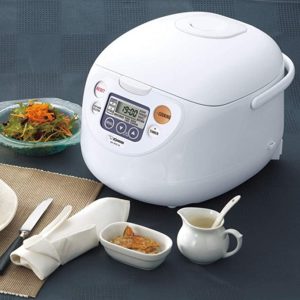 The technology in rice cookers has come a long way since they were introduced in 1945. There are four levels of technology currently being used in rice cookers. Each level uses the technology developed previously and adds something new to improve upon it. Without getting too technical, let’s go over those four levels.
The technology in rice cookers has come a long way since they were introduced in 1945. There are four levels of technology currently being used in rice cookers. Each level uses the technology developed previously and adds something new to improve upon it. Without getting too technical, let’s go over those four levels.
Level 1 – Basic
Basic rice cookers have a heating plate and a temperature sensor. When the sensor reaches a certain temperature, the rice is done, and the cooker will switch to keep-warm mode. These are the simplest and least expensive models of rice cooker.
Level 2 – Fuzzy Logic
These rice cookers have a micro-computer that uses fuzzy logic, a type of artificial intelligence, to adjust the heat output based upon certain variables for a more consistent result.
Level 3 – Induction Heating (IH)
Instead of a simple heating plate, these rice cookers use induction heating around the entire pot for a more controlled, even distribution of heat. IH works together with fuzzy logic to make great-tasting rice.
Level 4 – Pressure IH
By adjusting the pressure inside the pot, in conjunction with induction heating, these rice cookers have the utmost control over how the rice is cooked, resulting in fluffy, delicious rice every time. They are able to cook perfectly any variety of rice, as well as various other foods. At this level, the lines begin to blur between rice cookers, pressure cookers, and multicookers, like Instant Pots. These are the latest and most expensive models of rice cooker.
What to Look for When Buying a Rice Cooker
Size
An average-size rice cooker measures about 8 to 12 inches on all three sides (width x length x height). Rice Cookers produce steam while cooking, so you should avoid placing them under a cabinet while in use. Consider where you will store your cooker when not in use.
Capacity
Take care! The capacity of rice cookers is usually stated in terms of cups of rice. Depending on the manufacturer, however, this capacity could refer to either uncooked or cooked rice. Remember that a cup of uncooked rice will yield around 2 cups of cooked rice, so 5 cups of uncooked rice is twice as much as 5 cups of cooked rice. Keep that in mind when comparing models.
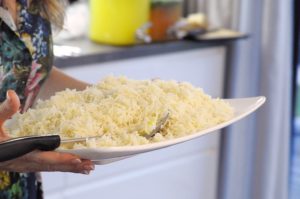
In terms of uncooked rice, the capacity for rice cookers ranges from 1 cup (mini-cookers) to 30 cups (industrial rice cookers). If storage space is an issue, stick to the smaller 3-cup models. Otherwise, a good target capacity would be between 5 cups for individuals or couples to 12 cups for a larger family or group. Higher-capacity rice cookers aren’t that much bigger space-wise than smaller ones. On the occasions you have extra guests or a large dinner party, you will be grateful for the extra capacity. You don’t have to make the maximum amount each time, though; even in large cookers, you can choose to make just 1 or 2 cups of uncooked rice. Some of the larger basic rice cookers have a minimum of 2 cups. If you put less than that, the rice won’t cook properly. Most fuzzy-logic rice cookers of all sizes can handle cooking just 1 cup or even just half a cup of rice.
Menu Settings
 Most rice cookers have different settings depending on what kind of rice you are cooking. White rice and brown rice are the most common settings, but others include sushi rice, sweet rice, jasmine rice, mixed rice, quick rice, as well as settings for softer or harder white rice. In addition, many models have settings for other types of food, such as porridge, oatmeal, steamed vegetables, quinoa, yogurt, cake, soup, chili, and pasta. Some rice cookers even double as a slow cooker or as a pressure cooker.
Most rice cookers have different settings depending on what kind of rice you are cooking. White rice and brown rice are the most common settings, but others include sushi rice, sweet rice, jasmine rice, mixed rice, quick rice, as well as settings for softer or harder white rice. In addition, many models have settings for other types of food, such as porridge, oatmeal, steamed vegetables, quinoa, yogurt, cake, soup, chili, and pasta. Some rice cookers even double as a slow cooker or as a pressure cooker.
Cooking Time
Some basic models can cook white rice in about 15 minutes. More advanced models actually take longer than basic models, about 50 mins to 1 hour for white rice and up to 2 hours for brown rice. As with many foods in the kitchen, perfectly cooked rice takes time. Some advanced models have a quick setting, which takes about 25 to 35 minutes for white rice, but the quality of the rice will most likely decrease. If speed is an issue for you, a less expensive, basic model makes more sense.
Miscellaneous features
Retractable cords: Makes storing away your rice cooker easier.
Time-delay: Allows you to set your rice cooker in the morning and come home to just-finished fresh-cooked rice.
Steamer tray: Use to steam your vegetables while you are cooking your rice.
Removable Inner-lids and steam vents: Makes cleaning your machine easier.
Finished Alert: When the rice is finished, the rice cooker will alert you with a beep, chime or melody.
Nonstick coating
There are different types of coating and material used to prevent rice from sticking to the pot. Some of these coatings tend to peel over time, no matter how carefully you follow the care guidelines. This happens in even the top-rated, most expensive models. Zojirushi, as an example, states in its manual, “The nonstick coating may eventually discolor or peel off. This will not affect its performance or sanitary properties, and is harmless to your health.” Peeling of the nonstick coating is one of the most common complaints across any model/manufacturer and is not covered under most warranties. If your pot’s coating does begin to peel, your options are to ignore it or replace it.
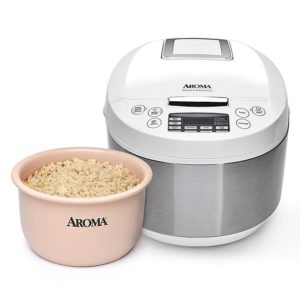
A replacement pot, if available, can run anywhere from 1/4 to 1/2 of the original cost of the cooker. This is something to consider when deciding whether to buy a high-end model. Do you want to spend $300~$500 on a rice cooker only to have the coating start to peel on you after six or twelve months? There is no way to know if this will happen to the rice cooker you choose, and only you can decide whether the peeling of the coating is acceptable. If not, some models feature a coating-free pot made from ceramic or stainless steel.
Price
You don’t have to spend a fortune to get a good rice cooker. The simplest models with the fewest menu settings start at around $30, and some of these receive excellent reviews for making quick, delicious-tasting rice. As you add technology and increase the number of settings, the price will rise accordingly. The most expensive models, with pressure induction heating and numerous settings, can run up to $500 or more. Loyal fans insist these high-end machines make rice that is heavenly, every grain cooked to absolute perfection, no matter what kind of rice they cook.
Roundup
There are great models that make delicious rice at every price point. Consider what your budget is and what features you need. Will you be making quinoa, porridge, or yogurt, or will you stick to plain white rice? Do you cook rice every day or twice a month? Is an hour a reasonable amount of time to wait for perfect rice, or do you want it more quickly? If your needs are simple, you can save some money by buying a less expensive model. On the other hand, if you want perfection in a rice bowl, splurge for the best.
HowToBuyA – Rice Cooker Suggestions
Now that you have a good idea of what to look for in a rice cooker, here are some of the best-reviewed cookers. The first group are non-Zojirushi Rice Cookers, which we have sorted by price. Scroll down if you are looking for a Zojirushi brand cooker with fuzzy logic, or click here.
Affiliate notice: When you buy through our links, we may earn a commission.
Non-Zojirushi Rice Cookers
Less expensive than Zojirushi brand rice cookers, these models are all capable of making great-tasting rice. There are a variety of sizes and features offered at prices ranging from less than $50 to $200.
Rice Cookers below $50

Aroma Housewares ARC-994SB 2O2O Model Rice & Grain Cooker Slow Cook, Steam, Oatmeal, Risotto, 8-cup cooked/4-cup uncooked/2Qt, Stainless Steel
1 to 4 Cups (uncooked)
8.5 x 9 x 9 inches

Instant Pot Zest Rice Cooker & Food Steamer, Cooks Rice, Grains, Quinoa and Oatmeal
1 to 4 Cups (uncooked)
8.74 x 8.46 x 9.25 inches

Aroma Housewares ARC-150SB Digital Rice Cooker, Slow Cooker, Food Steamer, Stainless Steel Exterior
2 to 10 Cups (uncooked)
11.13 x 11.25 x 10.75 inches

Hamilton Beach Digital Programmable Rice Cooker & Food Steamer, 8 Cups Cooked (4 Uncooked), With Steam & Rinse Basket, Stainless Steel (37518)
1 to 4 Cups (uncooked)
8.25 x 9.74 x 9.88 inches
Rice Cookers from $50 to $100

COMFEE’ MB-M25 Rice Cooker, Slow Cooker, Steamer, Stewpot, Saute All in One (12 Digital Cooking Programs)
2 to 10 Cups (uncooked)
11.02 x 10.75 x 10.75 inches

TIGER JBV-A10U Rice Cooker with Food Steamer Basket
1 to 5.5 Cups (uncooked)
Fuzzy Logic
13.9 x 10.6 x 8.4 inches

COMFEE’ MB-FS5077 5.2Qt Asian Style Programmable All-in-1 Multi Cooker, Rice Cooker, Slow Cooker, Steamer, Saute, Yogurt Maker, Stewpot with 24 Hours Delay Timer and Auto Keep Warm Functions
2 to 10 Cups (uncooked)
13.9 x 10.8 x 10.5 inches

Toshiba TRCS02 Digital Programmable Rice Cooker, Steamer & Warmer, One-Touch Cooking, 24 Hour Delay Timer and Auto Keep Warm Feature, White
1 to 3 Cups (uncooked)
Fuzzy Logic
11 x 9 x 8 inches
Rice Cookers from $100 to $200

Cuckoo CR-0632F Rice Cooker and Warmer, 10 Menu Options, Made in Korea
2 to 6 Cups (uncooked)
Fuzzy Logic
15.2 x 12.13 x 11.97 inches

Toshiba TRCS01 Rice Cooker with One-Touch Cooking, Brown Rice, White Rice and Porridge
1 to 6 Cups (uncooked)
Fuzzy Logic
14 x 8 x 8 inches (approx.)

Tiger JAX-T18U-K Rice Cooker with Food Steamer & Slow Cooker
2 to 10 Cups (uncooked)
Fuzzy Logic
14.6 x 11.1 x 9.8 inches

Toshiba TRSH01 Digital Programmable Multi-functional Rice Cooker, Slow Cooker, & Steamer with One-Touch Cooking, Low Carb Mode
1 to 5.5 Cups (uncooked)
Fuzzy Logic
11 x 10 x 8 inches
Zojirushi Rice Cookers
The most popular brand of rice cooker is Zojirushi, from Japan. They have a wide range of rice cookers in a variety of styles. Their most popular models are made in Japan, although they do offer several models made in China that also receive good reviews. Their fuzzy logic models, usually labeled “Micom,” range from about $125~$250 and are made in either Japan or China. Their induction-heating and pressure induction-heating models are made only in Japan, and they run from about $250~$500. For your convenience, we’ve grouped these models by where they were made. To see all of their models & prices on one page head here.
Zojirushi Rice Cookers – Made in Japan

NS-ZCC10 / NS-ZCC18
5.5 / 10 Cups (uncooked)
13 x 8.13 x 10.13 inches / 14.5 x 9.5 x 11.5 inches
Fuzzy Logic

NP-HCC10XH / NP-HCC18XH
5.5 Cups / 10 Cups (uncooked)
14 x 10 x 8 inches / 15.5 x 11 x 9.5 inches
Induction Heating

NP-NWC10XB / NP-NWC18XB
5.5 Cups / 10 Cups (uncooked)
9.1 x 9.1 x 9.1 inches / 11.1 x 16.5 x 10.1 inches
Pressure Induction Heating
Zojirushi Rice Cookers – Made in China

NS-WAC10-WD / NS-WAC18-WD
5.5 Cups / 10 Cups (uncooked)
13.25 x 10 x 8.63 inches / 14.38 x 11 x 9.88 inches
Fuzzy Logic

NS-TSC10 / NS-TSC18
5.5 Cups / 10 Cups (uncooked)
14 x 10.1 x 8.5 inches / 15 x 11.1 x 9.9 inches
Fuzzy Logic
Wrap Up
Great-tasting rice can really brighten a meal. We hope you have learned enough about how rice cookers work and what features to look for to find the best rice cooker for you. Let us know what kind of rice cooker you buy and why in the comments below.








1 comment
Josephsen
Im pretty pleased to discover this great site. I need to to thank you for ones time due to this wonderful read!! I definitely liked every bit of it and i also have you book marked to see new things in your website.